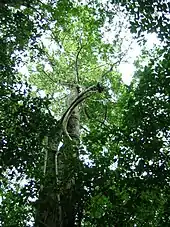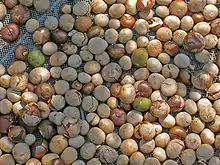Brosimum alicastrum
Brosimum alicastrum, commonly known as the breadnut or Maya nut, is a tree species in the family Moraceae of flowering plants, whose other genera include figs and mulberries. The plant is known by a range of names in indigenous Mesoamerican and other languages, including: ramon, ojoche, ojite, ojushte, ujushte, ujuxte, capomo, mojo, ox, iximche, masica in Honduras, uje in the state of Michoacan Mexico, and mojote in Jalisco, or also chokogou in Haitian Creole.
| Breadnut | |
|---|---|
 | |
| Scientific classification | |
| Kingdom: | Plantae |
| Clade: | Tracheophytes |
| Clade: | Angiosperms |
| Clade: | Eudicots |
| Clade: | Rosids |
| Order: | Rosales |
| Family: | Moraceae |
| Genus: | Brosimum |
| Species: | B. alicastrum |
| Binomial name | |
| Brosimum alicastrum Sw. | |
| Synonyms | |
|
Alicastrum brownei Kuntze | |
| Nutritional value per 100 g (3.5 oz) | |
|---|---|
| Energy | 908 kJ (217 kcal) |
46.28 g | |
0.99 g | |
| Saturated | 0.267 g |
| Monounsaturated | 0.126 g |
| Polyunsaturated | 0.527 g |
5.97 g | |
| Tryptophan | 0.162 g |
| Threonine | 0.232 g |
| Isoleucine | 0.338 g |
| Leucine | 0.647 g |
| Lysine | 0.260 g |
| Methionine | 0.035 g |
| Cystine | 0.093 g |
| Phenylalanine | 0.282 g |
| Tyrosine | 0.439 g |
| Valine | 0.578 g |
| Arginine | 0.549 g |
| Histidine | 0.091 g |
| Alanine | 0.271 g |
| Aspartic acid | 0.659 g |
| Glutamic acid | 0.835 g |
| Glycine | 0.375 g |
| Proline | 0.297 g |
| Serine | 0.400 g |
| Vitamins | Quantity %DV† |
| Vitamin A equiv. | 2% 12 μg |
| Thiamine (B1) | 5% 0.055 mg |
| Riboflavin (B2) | 5% 0.055 mg |
| Niacin (B3) | 6% 0.880 mg |
| Pantothenic acid (B5) | 22% 1.103 mg |
| Vitamin B6 | 31% 0.403 mg |
| Folate (B9) | 17% 66 μg |
| Vitamin B12 | 0% 0.00 μg |
| Vitamin C | 33% 27.4 mg |
| Minerals | Quantity %DV† |
| Calcium | 10% 98 mg |
| Copper | 72% 1.444 mg |
| Iron | 16% 2.09 mg |
| Magnesium | 19% 68 mg |
| Manganese | 8% 0.178 mg |
| Phosphorus | 10% 67 mg |
| Potassium | 25% 1183 mg |
| Sodium | 2% 31 mg |
| Zinc | 12% 1.13 mg |
| Other constituents | Quantity |
| Water | 45.00 g |
| |
| †Percentages are roughly approximated using US recommendations for adults. Source: USDA FoodData Central | |
Two subspecies are commonly recognized:
- B. a. alicastrum
- B. a. bolivarense (Pittier) C.C.Berg
Description
The tree can grow up to 45 m (130 ft) in height and up to 1.5 m in diameter.[1]
Distribution and habitat
This tree is found on the west coast of central Mexico and in southern Mexico (Yucatán, Campeche), Guatemala, El Salvador, the Caribbean, and the Amazon. Large stands occur in moist lowland tropical forests at 300–2000 m elevation (especially 125–800 m), in humid areas with rainfall of 600–2000 mm, and average temperatures of 24 °C (75 °F).[2]
History and culture
The breadnut fruit disperses on the ground at different times throughout its range. It has a large seed covered by a thin, citrus-flavored, orange-colored skin favored by a number of forest creatures. More importantly, the large seed which is enveloped by the tasty skin is an edible ‘nut’ that can be boiled or dried and ground into a meal for porridge or flatbread. Breadnut is nutritious and has value as a food source, and may have formed a part of the diet of the pre-Columbian Maya of the lowlands region in Mesoamerica,[3][4] although to what extent has been a matter of some debate among historians and archaeologists and no verified remains or illustrations of the fruit have been found at any Mayan archaeological sites.

It was planted by the Maya civilization 2000 years ago and it has been claimed in several publications by Dennis E. Puleston to have been a staple food in the Maya diet.[4] Puleston demonstrated a strong correlation between ancient Maya settlement patterns and the distribution of relic stands of ramon trees.[5]
Other research has downplayed the ramon's significance. In the modern era, it has been marginalized as a source of nutrition and has often been characterized as a famine food.
The tree lends its name to the Maya archaeological sites of Iximché and Topoxte, both in Guatemala and Tamuin (reflecting the Maya origin of the Huastec peoples). It is one of the 20 dominant species of the Maya forest.[6] Of the dominant species, it is the only one that is wind-pollinated. It is also found in traditional Maya forest gardens.[7]
Nutritional and culinary value
The breadnut is high in fiber, calcium, potassium, folate, iron, zinc, protein and B vitamins.[3] It has a low glycemic index (<50) and is very high in antioxidants. The fresh seeds can be cooked and eaten or can be set out to dry in the sun and eaten later. Stewed, the nut tastes like mashed potato; roasted, it tastes like chocolate or coffee. It can be prepared in numerous other dishes. In Petén, Guatemala, the breadnut is being cultivated for exportation and local consumption as powder, for hot beverages, and bread.
Other uses

Breadnut leaves are commonly used as forage for livestock during the dry season in Central America. The fruits and seeds are also used to feed all kinds of animals.[1][8]
Carbon farming applications
Brosimum alicastrum can be used for carbon farming as a nut crop or fodder.[9]
See also
- Artocarpus camansi, another plant also commonly known as "breadnut"
References
- Heuzé V., Thiollet H., Tran G., Hassoun P., Lebas F., 2018. Breadnut (Brosimum alicastrum). Feedipedia, a programme by INRA, CIRAD, AFZ and FAO. https://www.feedipedia.org/node/175
- Melgar in "Utilizacion Integral del Arbol Genero Brosimum" INCAP 1987
- Flannery, Kent; Puleston, Dennis E. (1982), "The Role of Ramon in Maya Subsistence", Maya Subsistence: Studies in Memory of Dennis E. Puleston, Academic Press, pp. 353-366
- Harrison, Peter D.; Turner, B. L.; Puleston, Dennis E. (1978), "Terracing, Raised Fields, and Tree Cropping in the Maya Lowlands: A New Perspective on the Geography of Power", Pre-Hispanic Maya Agriculture, University of New Mexico Press, pp. 225-245
- Stavrakis-Puleston, Olga (2015). Settlement and Subsistence in Tikal, The assembled work of Dennis E. Puleston (Field research 1961–1972). Oxford: British Archaeological Reports. ISBN 978-1-4073-1419-8.
- Campbell, D. G., A. Ford, et al. "The Feral Forests of the Eastern Petén" (2006), Time and Complexity in the Neotropical Lowlands New York, Columbia University Press: 21-55.
- Ford, A. "Dominant Plants of the Maya Forest and Gardens of El Pilar: Implications for Paleoenvironmental Reconstructions Archived November 9, 2013, at the Wayback Machine" (2008), Journal of Ethnobiology 28(2): 179-199.
- Fairchild, David. "The Ramon Tree of Yucatan (Brosimiim alicastrum)" (PDF). Florida State Horticultural Society Proceedings, Volume 58. p. 199.
- Toensmeier, Eric (2016). The Carbon Farming Solution: A Global Toolkit of Perennial Crops and Regenerative Agriculture Practices for Climate Change Mitigation and Food Security. Chelsea Green Publishing. p. 180. ISBN 978-1-60358-571-2.
External links
 Media related to Brosimum alicastrum at Wikimedia Commons
Media related to Brosimum alicastrum at Wikimedia Commons Data related to Brosimum alicastrum at Wikispecies
Data related to Brosimum alicastrum at Wikispecies- Maya Nut Institute
- The El Pilar Forest Garden Network
- Maya Forest Garden, Dominant Plant Species of the Maya Forest
- Crop of the Week: Maya Nut (Brosimum alicastrum, Moraceae)